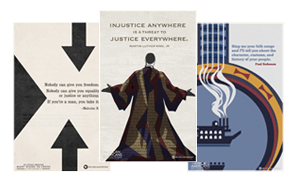Causes and Effects of Abolition ~ Lesson Activities
Lesson Activities
INTRODUCTORY ACTIVITY
1. Begin by asking students for a definition of causality, or “cause and effect.” (Accept all answers.) Once students have contributed their answers, provide them with this definition: Cause and effect is the relation between an event (cause) and a second event (effect), where the second event is understood as a direct consequence of the first. Write this definition on the board or show on overhead projector.
2. Explain to students that cause and effect is one of the guiding principles of the study of history. We try to understand why events happen in order to develop a comprehensive view of historical events. For any given event in history we can find a cause, and an effect – oftentimes several of each.
3. Write the following events on the board/overhead projector: The American Revolution
The 1918 Flu Pandemic
The first man walks on the Moon For each example, ask students what they think was the cause. Write answers on the board on the left side of the event. (Accept all reasonable answers.) Examples may include:
- Taxation without representation, British imperialism, Declaration of Independence;
- Spread of H1N1 flu virus, close quarters in World War 1, increased international travel;
- Cold War encourages Space Race, development of new arms technology, success of unmanned space missions.
Explain that many events have multiple causes – it is rare that a major historical event will have one isolated cause. Often several factors cause an event to occur. 4. Now that your students have identified some of the causes for these historical events, ask them to identify some of the effects. What impact did these events have on history? Write answers on the board on the right side of the event. (Accept all reasonable answers.) Examples may include:
- Establishment of independent United States of America, Constitution is written, War of 1812;
- High mortality of worldwide population, affected global economy, 2009 H1N1 flu pandemic;
- Civilian technological advances, emergence of NASA, future manned space missions.
Explain that much like with causes, events may have several political, cultural, social, and economic effects throughout history. These effects can be immediate – like the high mortality due to the flu virus – or can be felt much later on, like the resurgence of the H1N1 virus over 90 years later. We may not even know what some of the effects are yet – like future technological advances that may emerge from the space program.
5. Explain to students that while you have given them relatively straightforward examples to work with so far, for many events in history both the causes and effects can be unclear, complicated, or disputed. It’s not always easy to pinpoint the causes or effects, and it can require a good deal of thought and analysis. As you move forward with the lesson, encourage students to adopt a “cause and effect” focused view of historical events.
LEARNING ACTIVITY
1. Tell students that the abolishment of slavery in the United States was a major event, with many causes and lasting effects throughout history. We know that the Civil War and the Emancipation Proclamation were significant causes that led to the end of slavery, but what is not often recognized is that there were many, many smaller events that contributed to abolition. Tell students that in the 40 or so years leading up to the Civil War, an era known as the Antebellum period, numerous social, economic, and political factors as well as individual actions contributed to the abolition of slavery. Tell students that you will be showing them a series of videos from the PBS series The African Americans: Many Rivers to Cross that discuss events in the Antebellum period. As they watch the videos, they should try to identify the cause(s) and effect(s) of the central event in the video.
2. Tell students that the first video you are going to show them is about the revolution of the cotton industry. Play “Cotton Gin” for the class. When the video has finished, ask students to identify the cause(s) that led to the revolution of the cotton industry. (Answers should include Eli Whitney invents the cotton gin, the cotton gin is adopted by cotton growers in the South.) What were some of the effects? (More plantations started growing cotton, native people and plants were eliminated from lands claimed for cotton growing, boom in worldwide textile industry, relocation of many slaves to the Deep South.) Ask students what the term “Second Middle Passage” means. (Forced relocation of thousands of slaves to cotton plantations in the Deep South, disrupting families and social systems.)
3. Explain to students that the Second Middle Passage and its impact on families and relationships led to deep-seated anger and resentment in slave communities. Some of these people were driven to take dramatic action. One of the more well-known uprisings was led by Nat Turner, a slave in Virginia. Play “Nat Turner Rebellion” and remind students to look for causes and effects. When the video has finished, ask students to name the cause(s) of the Rebellion. (Second Middle Passage, British abolition of slavery in 1838, horrible practice of slavery in general.) Ask students to identify the effect(s) of Nat Turner’s Rebellion. (Southern plantation owners defended the practice of slavery more aggressively.) Tell students that the increased determination to keep the practice of slavery in the South led to a more prominent divide with the North.
4. Tell students that while Southern farmers and plantation owners were clinging to the institution of slavery, Northern abolitionists were also becoming more vocal and aggressive. White Northerners as well as free Black citizens were fighting for abolition. One man in particular, Frederick Douglass, had a major impact on the national abolition movement. Play “Frederick Douglass” for the class. When the video has finished, ask students to identify the cause(s) that led to Frederick Douglass becoming a national figure in the abolition movement. (He escaped from slavery to New Bedford, MA, joined a black church, caught the attention of William Lloyd Garrett while speaking against slavery, travelled as a speaker with a prominent anti-slave society.) What effect(s) did this have on the country? (The national debate over slavery intensified greatly.) Explain that although Douglass was one of the more well-known figures in the abolition movement, he was not the only slave to escape to the North.
5. Tell students that as the nation remained divided over the practice and abolition of slavery, the government felt it needed to take action. The controversial Fugitive Slave Act of 1850 was implemented by the government but opposed by many in the country. Play “Fugitive Slave Act.” When the video has finished, ask students for an explanation of the Fugitive Slave Act. (Legislation requiring all Northerners to report and turn in any potential runaway slaves.) What caused the government to enact this law? (Slaves escaping from Southern farms, households, and plantations, many using the informal network of roads and safehouses known as the Underground Railroad.) How was the country affected by the Fugitive Slave Act? (Northerners were legally required to act as police for the South, escaped slaves as well as free black citizens were in danger of being caught and returned to the South.)
6. Explain to students that these events were important precursors to the abolition of slavery in the United States. Based on the video clips shown and the causes and effects identified by the class, ask students to help build a timeline of the events during the Antebellum period that contributed to abolition. Write answers on the board. (You may accept all reasonable answers.) The timeline should look like this:
• Invention of the cotton gin revolutionizes the cotton industry → more plantations in the Deep South grow cotton → forced relocation of thousands of slaves to the Deep South (Second Middle Passage) → slave uprisings and rebellions → aggressive defense of slavery by Southerners and stronger abolitionist push from Northerners → increase in escaping slaves → Fugitive Slave Act of 1850
7. Ask students if they can identify some of the effects and events that followed from these causes. Write answers on the board as part of your abolition timeline. (Accept all reasonable answers; answers may vary depending on when in your curriculum this lesson is taught.) Answers may include:
• Civil War, Emancipation Proclamation, signing of the 13th, 14th, and 15th Amendments, Reconstruction, Jim Crow Laws.
Encourage students to think of long-term events, such as desegregation and the Civil Rights movement in addition to these short-term effects.
8. Tell students that an important part of viewing history in the context of causality is determining which events are directly related, and which are not. Explain that there is a maxim in scientific research that also applies to history: Correlation does not equal causation. This means that two events may be related to each other in the same context, but are not understood to be direct causes and effects of each other. Ask students if any of the causes or effects they identified from the video clips may not be directly related to the abolition of slavery. (Answers may include: elimination of native people and plants from lands claimed for cotton growing, Frederick Douglass joining a black church – relatively minor details that are not part of the larger picture.) Ask students how they can determine which events are causally related, and which are not. Oftentimes there are no set rules, we just have to properly contextualize the events and use critical thinking skills.
CULMINATING ACTIVITY
1. Now that the students have a grasp of cause and effect in historical study, ask them to apply it to modern-day events. Provide students with a list of major events in the United States from the 21st century. (You may wish to delete items from this list, or add your own items.)
• 2000 election recount, War on Terror, 2007-8 recession, election of Barack Obama as President in 2008, Hurricane Katrina, 2013 government shutdown, elimination of the Defense of Marriage Act.
2. Break students into small groups or pairs and assign each group one current event. Give each group a piece of flip chart paper, or ask them to use a computer or tablet. In class, or as a homework assignment, have the groups/pairs create a timeline, similar to the one the class made for abolition, for their assigned event. The timeline should include causes as well as effects – if the effects are not yet known, students should project what the effects may be in the future. Students may use relevant websites, newspapers, and magazines to create their timelines.
3. Have students present their work to the class when finished. Hang paper timelines around the classroom, or post digital timelines to a shared website.
SourceURL:file://localhost/Volumes/IBDepartment/User%20Folders/KnightC/Many%20Rivers%20to%20Cross/Lesson%20Plans/MRTC%20Antebellum%20Agents%20of%20Change_FINAL.doc
EXTRA CREDIT ACTIVITY
For extra credit, students may read The Autobiography of Frederick Douglass, and write a 1-2 page essay on the causes of Douglass’s rise to notoriety and the effects of his work as an abolitionist.
Find educational resources related to this program - and access to thousands of curriculum-targeted digital resources for the classroom at PBS LearningMedia.
Visit PBS Learning Media






